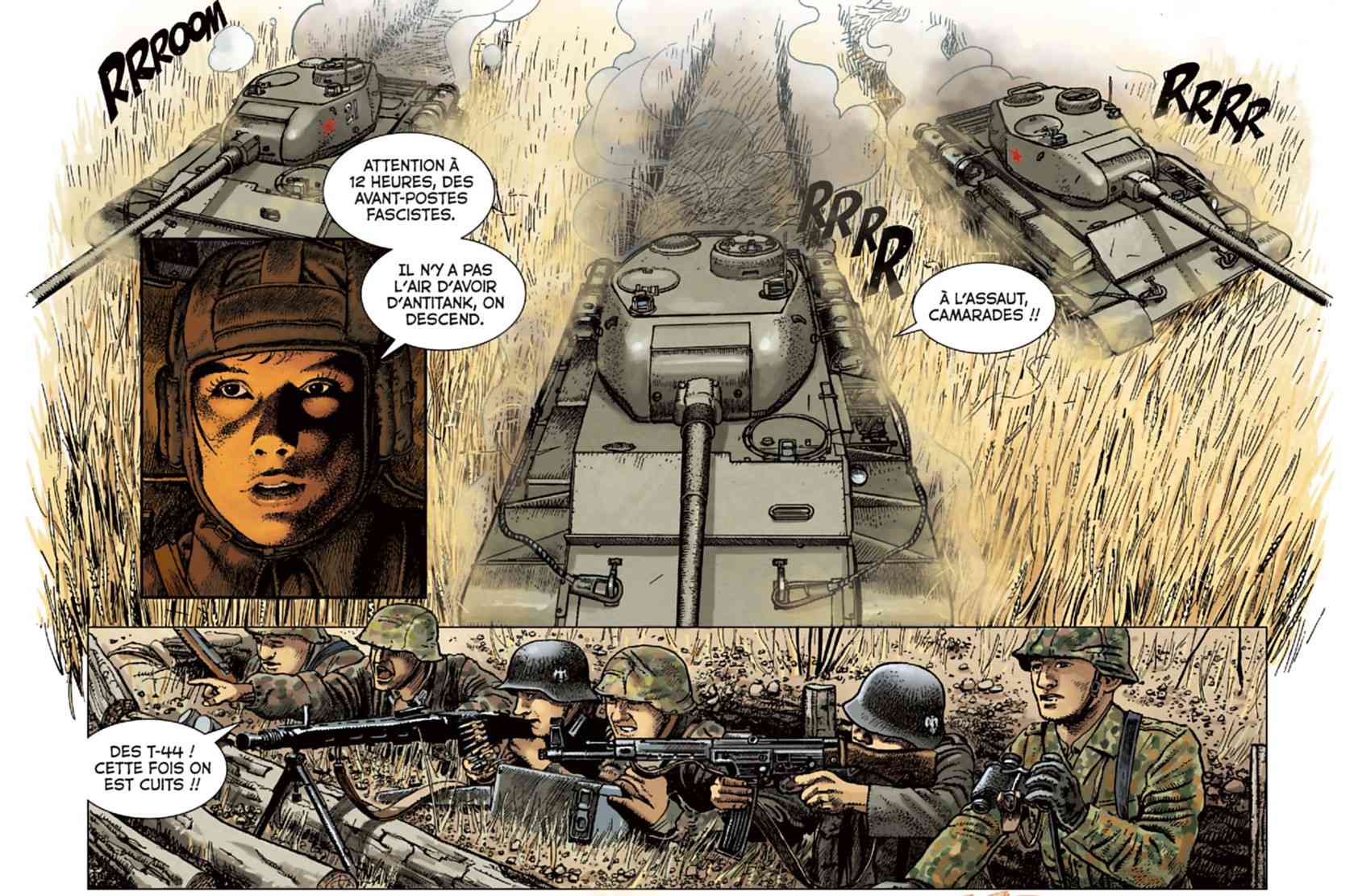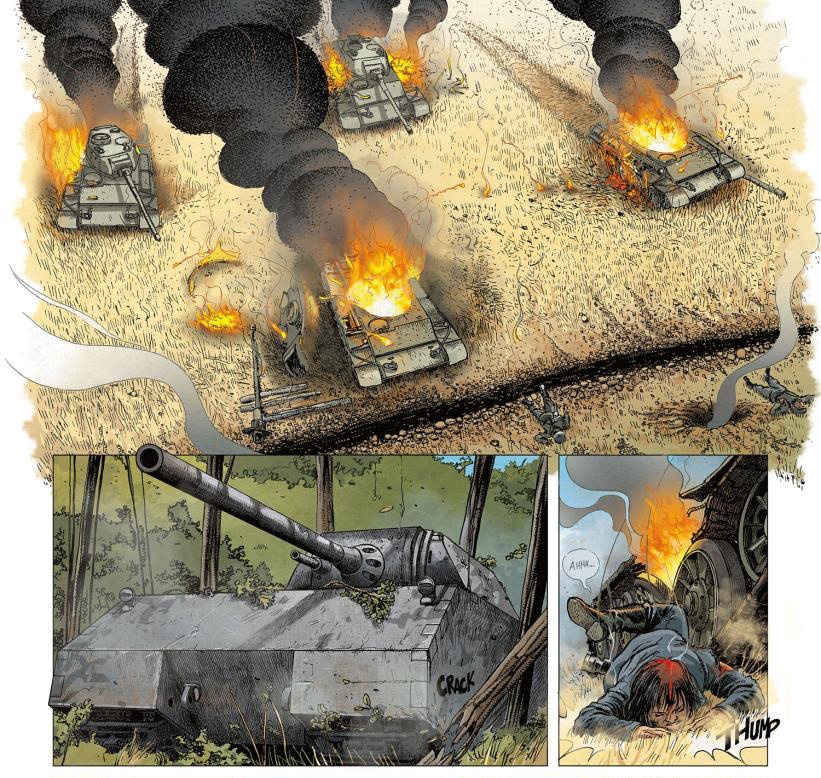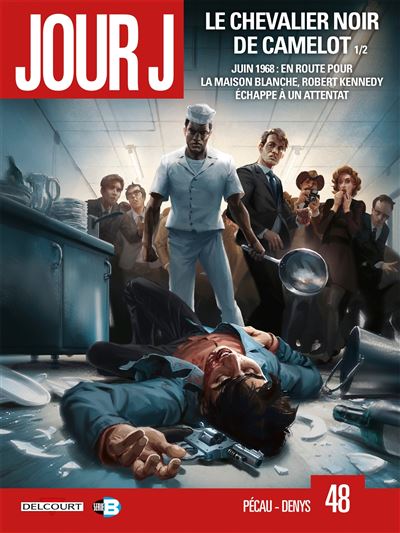The Second World War continues for Jean-Pierre Pécau and Sénad Mavric in the series of War Machines, studying the history of the main tanks of the conflict. The Gray Wolf is a special title because this German tank did not (almost) exist.
A Ghost Tale
 In 1947, fighting continued in East Prussia. The USSR dominated by a large margin and a small team of infantrymen fled. But an unknown tank appears and, in a matter of seconds and a few shots, it destroys the Soviet tank group. Only one lieutenant survived. She is convinced that it is the Gray Wolf. However, no member of the General Staff accepts its existence. For them, this powerful and invincible tank is a legend and it was a battery of heavy guns that caused this defeat. Only Commander-Major Konstandin Karadine has faith in his testimony. Together, they will investigate this ghost tank with the only clue being the testimony of the lieutenant and dubious German technical documents on the Maus tank project. Unlike the other volumes, The Grey Wolf relies much more on the imagination of the screenwriter than on historical reality. This tank is everywhere and nowhere. No one sees it but everyone talks about it. No weapons destroyed it. Karadine proposed to the lieutenant to lead her own team with the only example of heavy tank on the Western Front, the Tortoise. The duo hunting for the Gray Wolf is very mismatched. Karadine is cold, ruthless and has a rather peculiar humor. He denies the existence of summary arrests because a bullet is more economical than a trial. Ivana knows more about the reality on the ground but, due to the many victims that punctuate her career, she has the reputation of bringing bad luck. The first release will not debunk this myth.
In 1947, fighting continued in East Prussia. The USSR dominated by a large margin and a small team of infantrymen fled. But an unknown tank appears and, in a matter of seconds and a few shots, it destroys the Soviet tank group. Only one lieutenant survived. She is convinced that it is the Gray Wolf. However, no member of the General Staff accepts its existence. For them, this powerful and invincible tank is a legend and it was a battery of heavy guns that caused this defeat. Only Commander-Major Konstandin Karadine has faith in his testimony. Together, they will investigate this ghost tank with the only clue being the testimony of the lieutenant and dubious German technical documents on the Maus tank project. Unlike the other volumes, The Grey Wolf relies much more on the imagination of the screenwriter than on historical reality. This tank is everywhere and nowhere. No one sees it but everyone talks about it. No weapons destroyed it. Karadine proposed to the lieutenant to lead her own team with the only example of heavy tank on the Western Front, the Tortoise. The duo hunting for the Gray Wolf is very mismatched. Karadine is cold, ruthless and has a rather peculiar humor. He denies the existence of summary arrests because a bullet is more economical than a trial. Ivana knows more about the reality on the ground but, due to the many victims that punctuate her career, she has the reputation of bringing bad luck. The first release will not debunk this myth.
The tanks keep moving forward
 The Gray Wolf is the second January title by screenwriter Jean-Pierre Pécau and the fourth volume of this technical and human series. Links are made even if each volume can be read separately. Here we find the fact that women fought on the Soviet side. The secret police, the NKVD, inspects all the actions of the soldiers to control the information. No negative information should be disclosed even if it is true. The reader learns more about the war from the Soviet side. The losses are enormous: one unit was completely decimated three times during the war. The reader discovers different combat zones with very different tactics depending on whether you are in the countryside or in the middle of the ruins of a city. The Gray Wolf did exist. It was the heaviest tank ever built but proved totally useless. It is the symbol of Nazism, a regime passionate about gigantism but also proof of the failure of its war industry. The designer Sénad Mavric remains the driver of the series and remains as precise in the representation of uniforms and technical equipment of the vehicles. We also find at the end of the volume the very complete file with the plan and the real history of the Panzerkampfwagen VIII Maus. However, Sénad Mavric is colder in the representation of emotions on faces. Published by Delcourt, the Grey Wolf remains on the trail of the War Machines series. Precise drawing is at the service of historical accuracy, but this volume is distinguished by a greater use of imagination. The mystery of this invincible tank is well posed but the resolution can disappoint. You can find other chronicles on another volume of the same series with The Kursk Star and another series on war aviation.
The Gray Wolf is the second January title by screenwriter Jean-Pierre Pécau and the fourth volume of this technical and human series. Links are made even if each volume can be read separately. Here we find the fact that women fought on the Soviet side. The secret police, the NKVD, inspects all the actions of the soldiers to control the information. No negative information should be disclosed even if it is true. The reader learns more about the war from the Soviet side. The losses are enormous: one unit was completely decimated three times during the war. The reader discovers different combat zones with very different tactics depending on whether you are in the countryside or in the middle of the ruins of a city. The Gray Wolf did exist. It was the heaviest tank ever built but proved totally useless. It is the symbol of Nazism, a regime passionate about gigantism but also proof of the failure of its war industry. The designer Sénad Mavric remains the driver of the series and remains as precise in the representation of uniforms and technical equipment of the vehicles. We also find at the end of the volume the very complete file with the plan and the real history of the Panzerkampfwagen VIII Maus. However, Sénad Mavric is colder in the representation of emotions on faces. Published by Delcourt, the Grey Wolf remains on the trail of the War Machines series. Precise drawing is at the service of historical accuracy, but this volume is distinguished by a greater use of imagination. The mystery of this invincible tank is well posed but the resolution can disappoint. You can find other chronicles on another volume of the same series with The Kursk Star and another series on war aviation.

























![[Test] Call Of Duty Black Ops 6 : Un carton plein !!! Black ops 6](https://www.justfocus.fr/wp-content/uploads/2024/11/COD-UNREDACTED-004.jpg)














